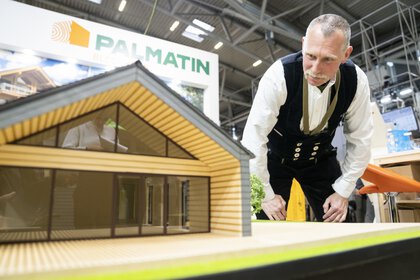Living in the future - how will we live?
Rents are rising, building land is becoming increasingly scarce and social developments are calling for new housing concepts. According to a study by the UN, global society in general is growing at a somewhat slower pace, but will reach 9.7 billion people by 2050. Accordingly, it will become increasingly important to use existing properties differently or rather to continue to use or upgrade them. In addition, resource-saving, sustainable housing concepts and strategies for redensifying unused space are more in demand than ever. BAU 2023 deals with these and other current challenges of the construction industry and shows what housing will look like in the future.
Why new housing models are so important in perspective
The situation on the housing market remains tense. The reasons are complex: shortage of materials, supply chain problems, densification in metropolitan areas and skyrocketing energy prices. Changing lifestyles and the associated future trends such as individualization, multifunctionality and self-fulfillment are added to the mix. The German government is trying to counteract this with a new target: 400,000 new homes are to be built each year - including 100,000 subsidized social housing units. But this target is difficult to achieve because there are many different challenges for housing in the future.

On the one hand, there are the global developments that make it difficult to plan and build new housing. On the other hand, the new housing models that result from social developments must first be created. There is a need for versatile spaces for home offices and smart co-working spaces to effectively reconcile private and work life. The housing market also needs age-appropriate and intergenerational solutions. For example, in the form of participatory housing models in which old and young people can live together. Not only, but especially the younger generations attach great importance to environmentally conscious living and housing. Green City is the keyword. They are strongly committed to the climate and demand sustainable, environmentally conscious, flexible and smart living models. The housing trends of the future include environmentally friendly construction in general, but also an improved indoor climate and larger green spaces.
What influences the housing trends of the future?
Numerous influences are shaping housing trends in the construction industry, chief among them climate change. The biggest challenges include increased precipitation, thawing permafrost, and indirect weather impacts, such as wildfires or severe flooding. In order to avoid these consequences and to act sustainably, the construction industry is already following the idea of a circular economy in some areas. Here, the focus is on recyclable building materials that can be recycled, 100 percent of which are returned to the sustainable cycle after use.

Furthermore, digital solutions for living in the future are increasingly in demand in terms of the digital transformation in planning and building. And this is true on the part of both companies and end consumers. Smart living concepts will be indispensable for the construction industry in the coming years. Another aspect influencing the housing trends of the future is the rising purchase value of building land per square meter: According to Statista, the value in Germany has risen from around 50 to 171 euros. Incidentally, the building land is often not owned by the municipalities themselves. The result is a vacancy rate of 43,083 apartments throughout Germany. In 2000, there were only 38,384 apartments.
The living concepts of the future
Based on these numerous influences, the idea of using existing properties in different ways is heading in the right direction. There are also other innovative, pioneering housing concepts for the future:
- Using existing stock for new housing: New housing can be created from office buildings, factories or warehouses, provided conversions are technically and legally feasible. Unconventional ideas are also needed here, such as residential construction over parking lots or supermarkets.
- Closing gaps through redensification: There are still too many gaps between buildings that need to be closed - either with new construction or by adding stories to existing buildings.
- Living in the future with these new types of concepts: Co-working spaces, shared villas, responsive homes, micro-apartments, tiny houses, smart homes or floating houses are considered promising examples.
- Housing trends of the future include the latest technologies: These can be energy-efficient appliances and app applications, such as smart kitchen robots or personalized interior design.
- AI-controlled smart home systems, such as automated controls for lighting or locking systems, save energy in houses and apartments.
- AAL (Ambient Assisted Living) refers to systems that are able to support people in their living environment in a situation-dependent and unobtrusive manner. This helps older people, those in need of care, or those with physical limitations to be able to move around the home independently.
